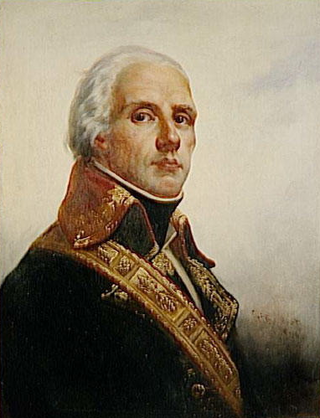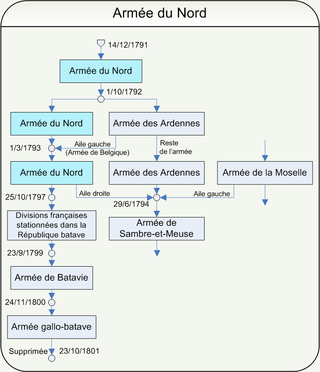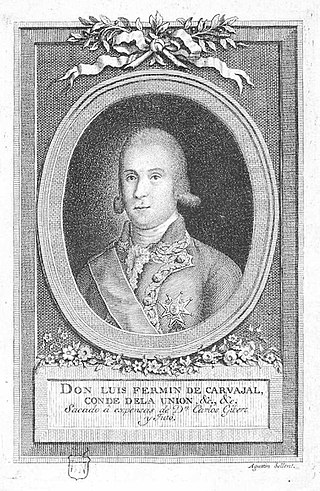Contents
This article needs additional citations for verification .(May 2016) |
| |||||
| Decades: | |||||
|---|---|---|---|---|---|
| See also: | Other events of 1794 List of years in Spain | ||||
Events in the year 1794 in Spain .
This article needs additional citations for verification .(May 2016) |
| |||||
| Decades: | |||||
|---|---|---|---|---|---|
| See also: | Other events of 1794 List of years in Spain | ||||
Events in the year 1794 in Spain .

1809 (MDCCCIX) was a common year starting on Sunday of the Gregorian calendar and a common year starting on Friday of the Julian calendar, the 1809th year of the Common Era (CE) and Anno Domini (AD) designations, the 809th year of the 2nd millennium, the 9th year of the 19th century, and the 10th and last year of the 1800s decade. As of the start of 1809, the Gregorian calendar was 12 days ahead of the Julian calendar, which remained in localized use until 1923.

Charles IV was King of Spain and ruler of the Spanish Empire from 1788 to 1808.

The War of the Pyrenees, also known as War of Roussillon or War of the Convention, was the Pyrenean front of the First Coalition's war against the First French Republic. It pitted Revolutionary France against the kingdoms of Spain and Portugal from March 1793 to July 1795 during the French Revolutionary Wars.

Jacques François Coquille, known as Dugommier, was a French military leader during the French Revolutionary Wars.

The Army of the North or Armée du Nord is a name given to several historical units of the French Army. The first was one of the French Revolutionary Armies that fought with distinction against the First Coalition from 1792 to 1795. Others existed during the Peninsular War, the Hundred Days and the Franco-Prussian War.

Luis Fermín de Carvajal, 1st Count of la Unión became a general officer in the army of the Kingdom of Spain. In 1794 during the French Revolutionary Wars, he commanded the Spanish Army in a mostly unsuccessful effort to hold back the army of the First French Republic. He died in battle fighting the French.

The Army of the Eastern Pyrenees was one of the French Revolutionary armies. It fought against the Kingdom of Spain in Roussillon, the Cerdanya and Catalonia during the War of the Pyrenees. This army and the Army of the Western Pyrenees were formed by splitting the original Army of the Pyrenees at the end of April 1793 soon after the war started. Shortly after the Peace of Basel on 22 July 1795, the fighting ended and the army was dissolved on 12 October that same year. Many of its units and generals were transferred to join the Army of Italy and fought under Napoleon Bonaparte in 1796.
The following lists events that happened during 1794 in the French Republic.

The Battle of the Black Mountain was fought from 17 to 20 November 1794 between the army of the First French Republic and the allied armies of the Kingdom of Spain and the Kingdom of Portugal. The French, led by Jacques François Dugommier defeated the Allies, who were commanded by Luis Firmín de Carvajal, Conde de la Unión. Though the Spanish right wing held, its left flank was driven back on the first day's fighting. On the last day of the battle, the French overran a key position and put the Spanish army to rout.

The siege of Roses began on 28 November 1794 and lasted until 4 February 1795 when the Spanish garrison abandoned the port and the forces of the First French Republic took control. Dominique Catherine de Pérignon commanded the French army and Domingo Salvator Izquierdo led the Spanish defenders. The siege took place during the War of the Pyrenees which was part of the French Revolutionary Wars. The war ended in July 1795 and Roses was soon restored to Spain. Roses is a coastal city in northeastern Spain, located 43 kilometres (27 mi) northeast of Girona, Catalonia.
Eustache Charles Joseph d'Aoust was a general officer during the French Revolutionary Wars.

Antonio Ricardos Carrillo de Albornoz was a Spanish general. He joined the army of the Kingdom of Spain and fought against Habsburg Austria, the Portugal, and the First French Republic during a long military career. By embracing the Spanish Enlightenment, he earned the displeasure of conservative elements of society. He played an active role in reforming the Spanish military. Upon the outbreak of the War of the Pyrenees in 1793, the king sent him to command in Catalonia. He invaded Roussillon where he won several victories over the French. After his death in early 1794, the war went badly for Spain.
Louis-Charles de La Motte-Ango, vicomte de Flers joined the French Royal army and rose in rank to become a general officer in the French Revolutionary Wars. After serving in the Austrian Netherlands, he was appointed to command the Army of the Eastern Pyrenees. His army suffered several defeats in May and June 1793, but he rallied his troops to win a defensive victory at the Battle of Perpignan in July. The all-powerful Representatives-on-mission arrested him in August 1793 for a minor setback and sent him to Paris under arrest. The Committee of Public Safety executed him by guillotine on trumped up charges in the last days of the Reign of Terror. De Flers is one of the names inscribed under the Arc de Triomphe.
Jerónimo Morejón Girón-Moctezuma, 3rd Marquis de las Amarillas, born 7 June 1741 at Málaga and died 17 October 1819 at Seville, became a general officer in the army of the Kingdom of Spain and commanded division-sized combat units during the War of the Pyrenees in 1793 and 1794. Though he attained high rank, becoming Viceroy of Navarre, he displayed limited military talent. Shortly after succeeding to the top command of the Army of Catalonia, he was dismissed for blunders made on the battlefield.

Juan Courten y Gonzalez was a Spanish military officer. He began his career in the War of the Austrian Succession at the age of 14. Courten fought in the Spanish–Portuguese War (1761–1763), the Invasion of Algiers in 1775, and the Great Siege of Gibraltar. He was the last Spanish governor of Oran in 1792. As a lieutenant general, he led an infantry division during the War of the Pyrenees against the First French Republic in several actions including Perpignan, Peyrestortes, Truillas, Boulou, and the Black Mountain. He was appointed Captain General of Aragon in 1795.
Events from the year 1808 in Spain.
Events from the year 1756 in France

The siege of Collioure saw a Republican French army led by Jacques François Dugommier invest the French port of Collioure held by a Spanish garrison commanded by Eugenio Navarro. The actual siege work was carried out by Pierre François Sauret's reinforced division. After the three-and-a-half-week War of the Pyrenees siege, the Spanish fleet sent to evacuate the garrison was blown off station by a storm. Navarro surrendered the town on the promise to exchange the paroled garrison for an equal number of French prisoners. After the defenders were released, the Spanish army commander Luis Fermín de Carvajal, Conde de la Unión refused to authorize the agreement or return any French captives. The infuriated French government afterward passed a decree ordering death to all Spanish prisoners and some units carried out the brutal order.